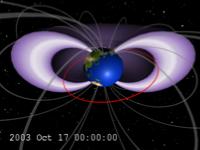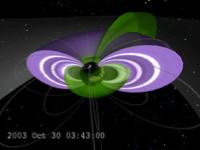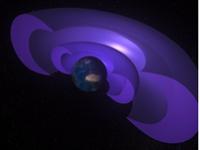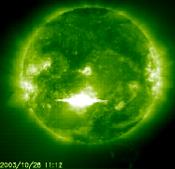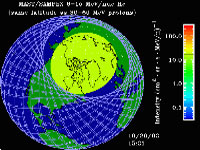|
|
|||||
|
During Legendary Solar Storms ..
In
October 2003, huge bursts of plasma generated powerful electric fields,
pushing Earth's outer atmosphere (plasmasphere), into interplanetary space.
Without the plasmasphere in the safe zone (gap between the two rings),
a new, intense radiation belt formed in the region. The red ring represents
the potential orbit of a satellite. In some periods it travels through
the gap, but at the storm's peak, the gap is filled in with radiation.
Print
resolution stills Credit: NASA - Click on image for animation
Earth's Safe Zone Became Hot
Zone During Legendary Solar Storms
Scientists realize that space is dangerous for unprotected satellites and astronauts, but they thought that they had found a small safe zone around Earth's radiation belt -- a shelter from these dangerous solar storms. It turns out that when the solar storm is strong enough, even this safe zone can become a major hot zone for dangerous radiation. "Space weather matters -- we now know that no matter what orbit we choose, there is the possibility that a spacecraft could get blasted by a significant dose of radiation. We need to take this into account when designing spacecraft. We also need to the ability to continuously monitor space weather so satellite operators can take protective measures during solar storms," said Dr. Daniel Baker, Director of the Laboratory for Atmospheric and Space Physics at the University of Colorado, Boulder.
In
this view, the plasmasphere (shown in green) is blown out to the magnetopause
(gray barrier), the main point of contact between the solar wind and Earth's
protective magnetic field lines. Visualization is based on data from the
IMAGE spacecraft. Print
resolution stills Credit: NASA - Click on image for animation
The
safe zone appears as a gap between the inner and outer 'donut,' beginning
about 7,000 km (4,350 miles) and ending about 13,000 km (8,110 miles) above
the Earth's surface. Credit: NASA - Click on image for animation
To call the Sun active in late October / early November is an understatement. Within a two-week period, the Sun released an unusually high number of coronal mass ejections (CMEs) into space, and experienced explosions many times more powerful than anything ever observed. For some perspective, flares are usually ranked by number and class. A large flare might be X-2, for example. The Nov. 4 flare was ranked X-28, although more precisely, "off the scale" because it was hard to get an exact measurement. To add to the drama, the Sun is headed into its period of minimum activity within its 11-year cycle, making the number and intensity of the fall flares unusually high. The maximum and most active period occurred around 2000-2001.
From
Oct. 22 to Nov. 4, 2003, at least eight solar shocks reached Earth, severely
disturbing its protective magnetic field and affecting orbiting spacecraft.
The SOHO spacecraft tracked the explosions in the Sun's outer atmosphere,
or corona. Credit: NASA/ESA - Click on image for animation
Advanced
warning saved a lot of spacecraft and power grids on Earth from serious
damage. Aircraft were rerouted, and astronauts on the International Space
Station took temporary shelter. This data from SAMPEX is overlaid on a
grid showing the ISS orbits and its frequent interaction with the radiation.
Credit: NASA/LASP - Click on image for animation
Additional Links:
|
|||||
| FAIR USE NOTICE: This page contains copyrighted material the use of which has not been specifically authorized by the copyright owner. Pegasus Research Consortium distributes this material without profit to those who have expressed a prior interest in receiving the included information for research and educational purposes. We believe this constitutes a fair use of any such copyrighted material as provided for in 17 U.S.C § 107. If you wish to use copyrighted material from this site for purposes of your own that go beyond fair use, you must obtain permission from the copyright owner. | |||||
|
|
